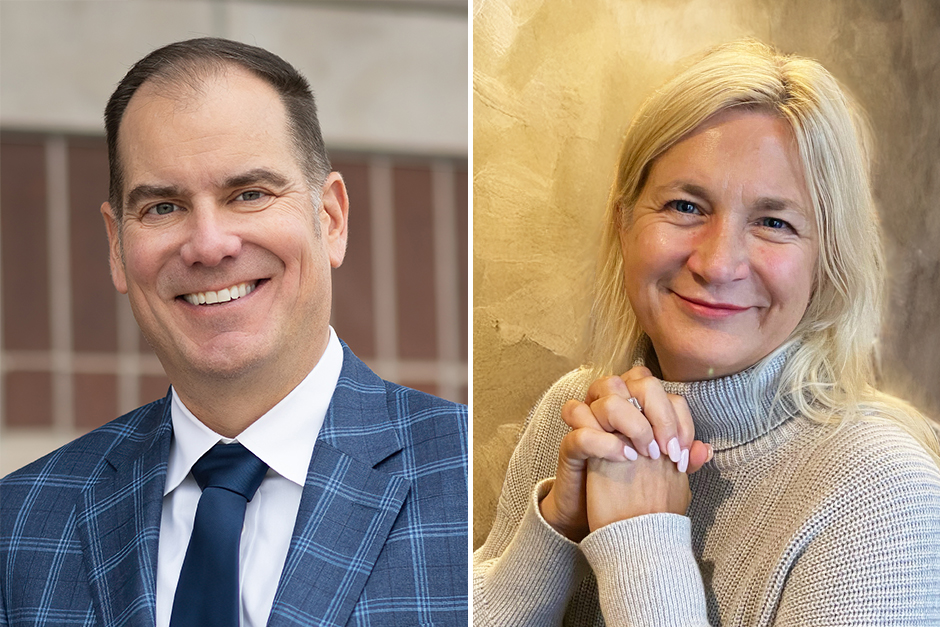In Brief
New Ram logo
Cornell’s Ram logo has been revised and updated by Matt Miller ’94, who created the most recent Ram logo in 2000.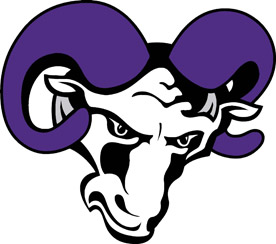
Before 1948, Cornell athletic teams were known as the Purples or the Hilltoppers. But no one was particularly fond of names so lacking in, well, pizzazz. So the 1949 Royal Purple yearbook staff held a contest and offered a $5 prize to come up with a new name. Keith Colvert ’51 came up with the Rams, pocketed the prize, and established a tradition that exists today.
Early on there was some play on the word “Ram.” First-year teams in 1949–50 were called “Ramlets.” The name was soon axed. Women’s teams were almost, but not quite, called “Cornell Ewes.” As recently as 1988, a letter to the editor in The Cornellian suggested the nonsexist name “Sheep.” That name was put out to pasture.
100th Cornell Fellow
There were no streamers, no banner, and no one won a lifetime supply of anything, but the Cornell Fellows program passed an impressive milestone this year with its 100th Fellow placed since the program began.
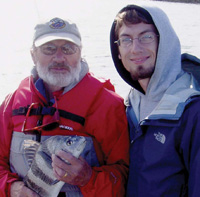
Three students—seniors Matt Shimanovsky (Riesen Fellow in Public Affairs, Institute for Justice), Jessica Morton (Rogers Fellow in Environmental Studies, South Carolina Aquarium), and Ben Rees (Rogers Fellow in Environmental Studies, Baruch Institute for Marine and Coastal Studies)—were placed at the same time, effectively tying for 100th.
“We are very proud of the accomplishments all of our Cornell Fellows have had in helping us reach this point,” said RJ Holmes
’99, director of career engagement programs. “Fellowships have taken students all over the world, and have added considerable value to the learning experience of our students.”
Here’s to 100 more.
Whisler takes over at Cole
Laurel Whisler has been appointed to the position of college librarian at Cole Library effective July 1.
Whisler earned a B.A. in music at Earlham College, an M.A. in music at Pennsylvania State University, and an M.L.S. at Indiana University. She has held administrative positions in libraries the past nine years and currently serves as the assistant director of library services and reference librarian at Southern Wesleyan University in Central, S.C.
Whisler’s husband, Bruce, is a trumpeter and music instructor.Their daughter, Katherine, is nearly 7.
Home run project
This spring marked the first season on the Rams’ new softball field. Located on the south side of campus, the field is equipped with lights and a protective tarp for inclement weather. The complex features a completely refurbished playing surface, a 10-by-20 foot scoreboard, new dugouts, bullpen areas, and a press box above the first base dugout.
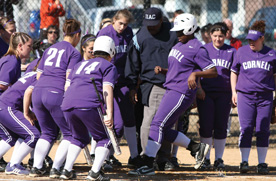
The $130,000 project is the culmination of a joint effort between the Mount Vernon Community School District and Cornell College.
“This elevates our playing field to one of the premier facilities in the Iowa Conference,” Cornell Director of Athletics John Cochrane said. “The softball field is the culmination of the efforts of so many people in the Mount Vernon community. In addition to the financial contributions from Cornell, the Mount Vernon Community School District, and the Mount Vernon Athletics Booster Club, this project simply was not possible without incredibly generous contributions from members of the community and its businesses.”
The softball team celebrated the new digs with a 6–2 victory over St. Ambrose on March 24, 2009. The first runs were driven in by senior Kim Cox in the first inning on a three-run double.
Off-campus photo winners
Senior Jessie Strains’ first glimpse of the Eiffel Tower was from a nearby neighborhood, a perspective she says shows its grandeur alongside the beauty of Parisian buildings. Strains studied politics in Germany and took the trip to Paris to learn about the political and historical connections between Germany and France.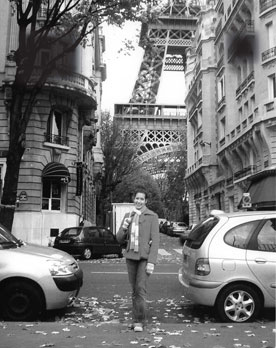
This photo was among the winners in Cornell’s first off-campus studies photo contest. To view more astounding photos by Cornell students, go to the off campus studies Web site.
Small world
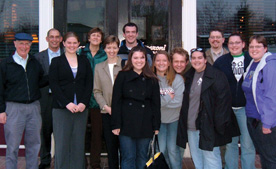
Cornellians tend to congregate in certain cities after graduation. Cedar Rapids. Chicago. Minneapolis. Washington, D.C. In some areas it’s not uncommon to bump into a Cornellian sporting some purple, a Ram, or a “Cornell College” shirt.
Salt Lake City is not one of those areas.
So three students in Cynthia Strong’s Advanced Analytical Chemistry class—in town for the National Meeting of the American Chemical Society—were rightly surprised when a man in a passing car shouted at them as they walked down the street.
“Hey, are you from Cornell College?”
That man was Douglas Smith ’73, and he just happened to recognize the Ram on senior Don Bladt’s jacket. The students, in turn, invited Smith to dinner that night, which Smith attended with his wife, Trustee Virginia (Ginger) Soper Smith ’73. The Soper family has a long history with Cornell (see story below), dating nearly back to the founding of the college. Since then, Sopers of many generations have matriculated at Cornell.
Strong said the dinner was a highlight of the trip, and that the students thoroughly enjoyed visiting with the Smiths.
The latest in a long line of Cornellians
This year, the latest in one of the longest Cornell family lines added his name to the ranks of the Soper-Rigbys who have graduated from the Hilltop.
Pat Kelly—a relative of the Soper, Rigby, Fellows, and Tunnicliff lines—graduated from Cornell with a degree in biology and plans to attend law school or pursue graduate studies in biology.
Kelly’s ancestors reach back to the founding days of Cornell. His great-great-great-grandfather Washington Augustus Rigby was the father of William Titus Rigby, also known as “The Captain.” The Captain was an early trustee of the college and an officer in the Union army, as was Erastus B. Soper, another relative of Kelly’s. The Rigby and Soper lines joined in 1868 when Elizabeth Cory 1868 (of the Rigby line) married E.B. Soper 1868—who later was president of the Cornell Board of Trustees credited with raising money for the Alumni Gymnasium.
William Arthur Rigby 1905 and Grace Tunnicliffe Rigby 1905, Kelly’s great-grandparents, met at Cornell. The Rigby name continued onto Kelly’s grandmother. Kelly is even related to the Bracket family. Lizzie Bracket Spear, who donated Bracket House to Cornell, was a cousin of Kelly’s grandmother.
All told, the Soper-Rigby family line has produced more than 200 Cornellians.
Kelly, however, was completely unaware of his family history when he arrived in Mount Vernon.
“I’d known of some Rigbys, Sopers, and Tunncliffs attending in the distant past but assumed there were only a few,” said Kelly, who added that, because he didn’t know any of them prior to applying to Cornell, it had no bearing on his decision. He said he chose the school mostly for One Course At A Time.
It was only after he arrived on campus that he became aware of his family history. His great-aunt, Alice Rigby, had done some research in the 1980s and 90s, and eventually passed it on to Kelly’s mother.



